Peoria Audubon Society is a local affiliate of both:
National Audubon Society & Illinois Audubon Society

Photo Gallery
2011 Peoria Hummingbird Festival
Saturday, August 27
The Peoria Audubon Society jointly hosted the 2011 Peoria Hummingbird Festival with the Illinois Audubon Society and the Peoria Park District. Before the 9:00 AM start time at Forest Park Nature Center, people were already streaming in -- anxious to see these remarkable little creatures. For a small donation ($5.00+ suggested) to the Illinois Audubon land acquisition fund, participants could "adopt" a hummingbird.
Dennis Endicott, webmaster for Peoria Audubon, took a few photos to remember the event.
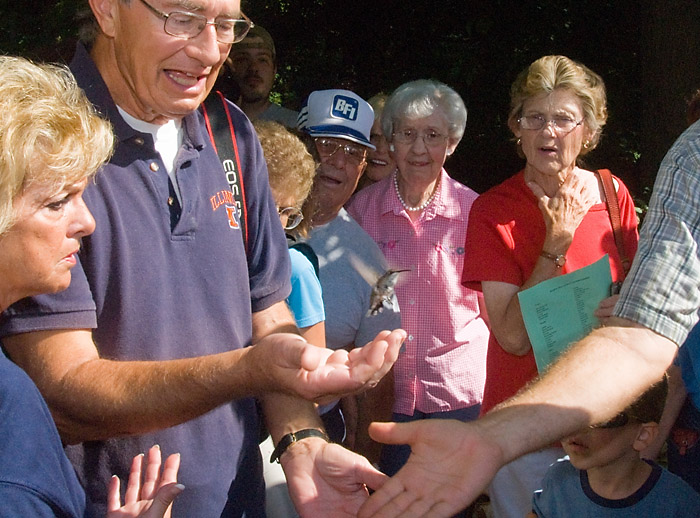
Awesome Release of Adopted Ruby-throated Hummingbird
After banding, the "adopter" releases the hummingbird. In the above photo, the banded ruby-throated hummingbird, which was in a state of torpor (a hibernation-like state of inactivity) while being banded, was placed in the adopter's hand. Then, a simple tap from underneath launched the hummingbird to to the air to fly away. The hummingbird paused for a very brief fraction of a second, as if to get its bearings, then flew away.
Dennis Endicott, webmaster for Peoria Audubon, took a few photos to remember the event.

Susie Grana Ingram Showing Off Hummingbird Art
With the face painting for the kids, Susie couldn't resist to show off the talent of the artists.
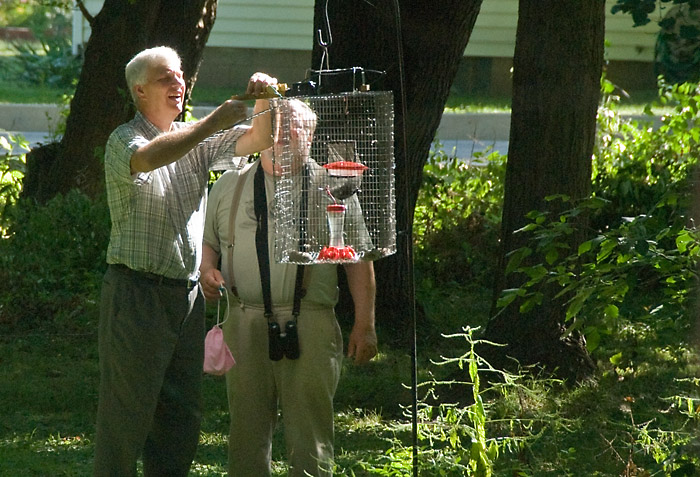
Vern Kleen and Maury Brucker Rigging Trap to Capture Hummingbird
Before you can band a hummingbird, you have to capture a hummingbird. In the above image, Vern is setting up and demonstrating the remote control to Maury Brucker of the Peoria Audubon Society. Vern emphasized to Maury that he needs to wait to click the remote control until after the hummingbird lands on the bird feeder. Vern indicated that the hummingbirds are so quick, that unless the bird was perching on the feeder, they could very quickly fly out of the trap before the door fully closed.
Vernon Kleen, of the Illinois Audubon Society, is one of only two people in the state of Illinois that are licensed to band hummingbirds.
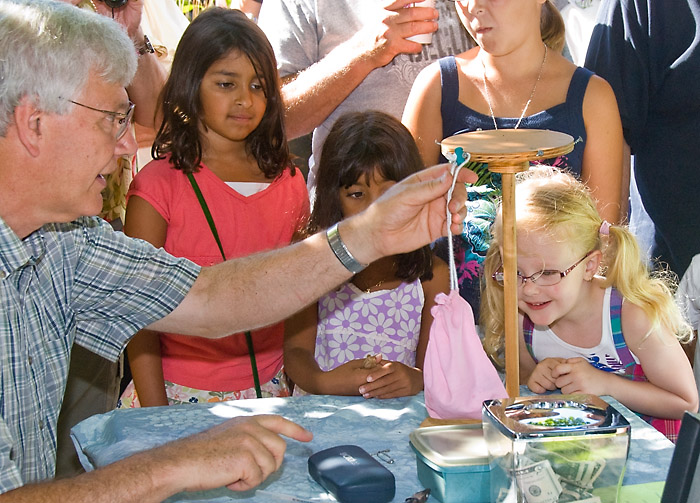
Captured Hummingbird is Safely Transported in Pink Cloth Bag
After the hummingbirds are captured in the trap, they are carefully transferred to the banding table in a pink cloth sack. Having the birds carefully suspended in the light bags helps keep them safe. Interestingly, Vern said that his wife made the cloth bags for him from an old sheet.
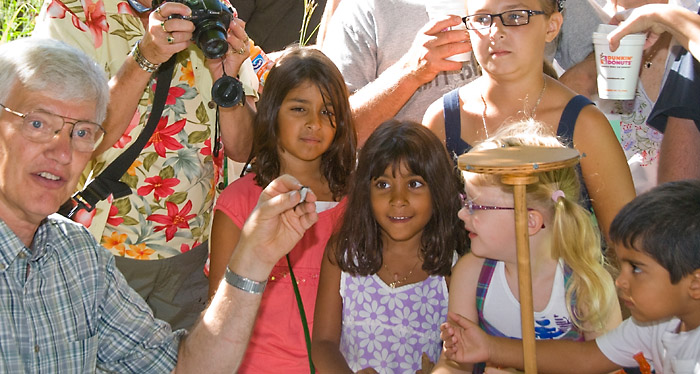
Vern Shows Ruby-throated Hummingbird to Excited Crowd
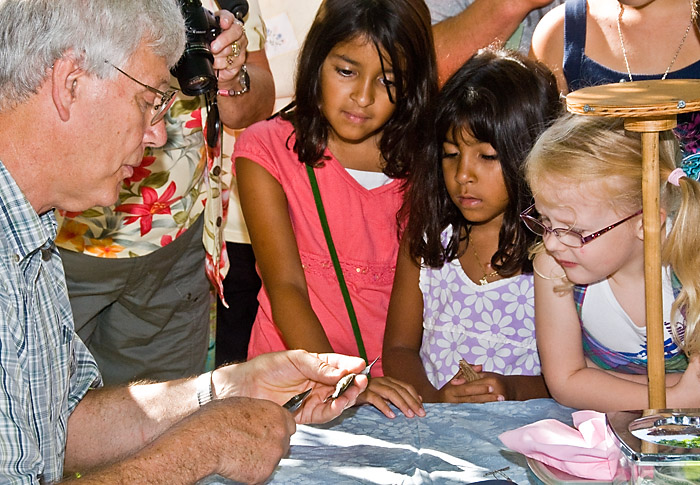
Children Watch Intently Watching as Vern Bands Hummingbird
Verne indicated that by banding hummingbirds, we are able to gather valuable information about them. For instance, if a hummingbird lives past the first year, they may live for 3-5 years. It is possible that some may even live further. Vern said that with his previously banded hummingbirds, there was one unique individual that he captured for 4 years straight. This belies how they may return to the same location year after year.
One of the more amazing facts is that ruby-throated hummingbirds migrate across the Gulf of Mexico to winter in Mexico and parts of Central America. Since there are no "filling-stations" over the ocean, the hummingbirds pack on the calories in the short time before their migration. During this time, they increase in weight from 3 grams to a "whopping" 5 grams. The increase in body fat helps fuel them toward their winter destination.
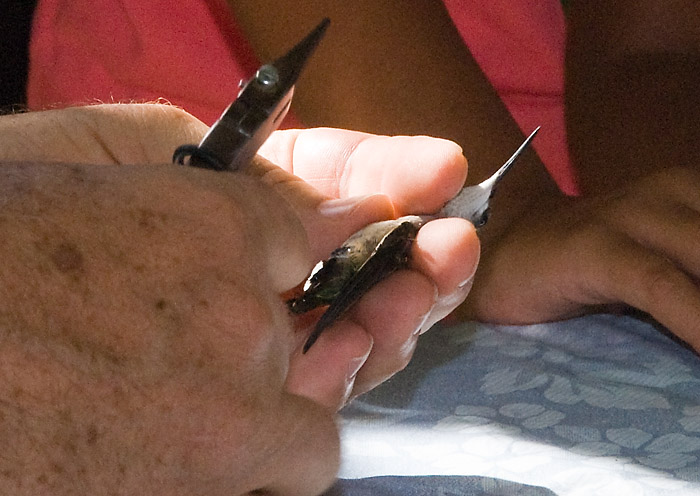
Vern Verifies Safety and Integrity of Hummingbird Band
After recording measurements, Vern band the hummingbird. Then, he verifies that the band is loose enough so as to not disturb the hummingbird
Vern said that for feeding hummingbirds, use 1 part sugar (regular granular cane sugar) to 4 parts of water. That is 1 cup sugar dissolved in 4 cups of water. Bring the mixture to a quick boil, cool and use. Do not use the commercial "hummingbird food," as these contain a red dye that accumulates within the hummingbird as their kidneys cannot excrete it from their system.
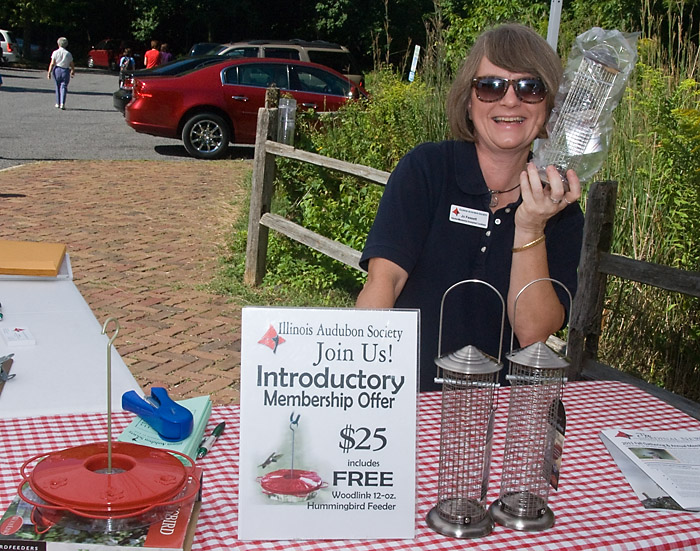
Jo Fessett Promotes IAS Memberships with Free Feeder
Jo Fessett from the Illinois Audubon Society was on hand to provide a complementary feeder with an introductory membership with Illinois Audubon.
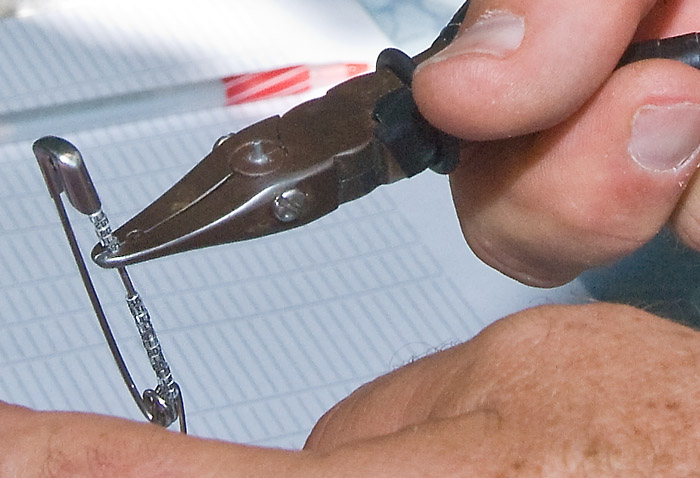
Extra Hummingbird Bands are Kept on Safety Pin
Vern stores his pre-formed hummingbird bands on a safety pin. This keeps them undamaged and ready for use. Vern explained that he had to cut each one out with a razor blade from a card that he gets from the US Fish and Wildlife Service.
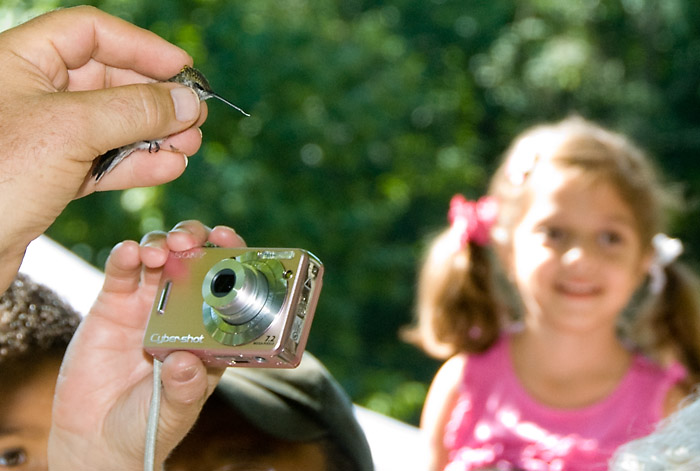
Vern Shows Ruby-throated Hummingbird to Crowd
Before release, Vern showed each of the newly banded hummingbirds to the crowd.
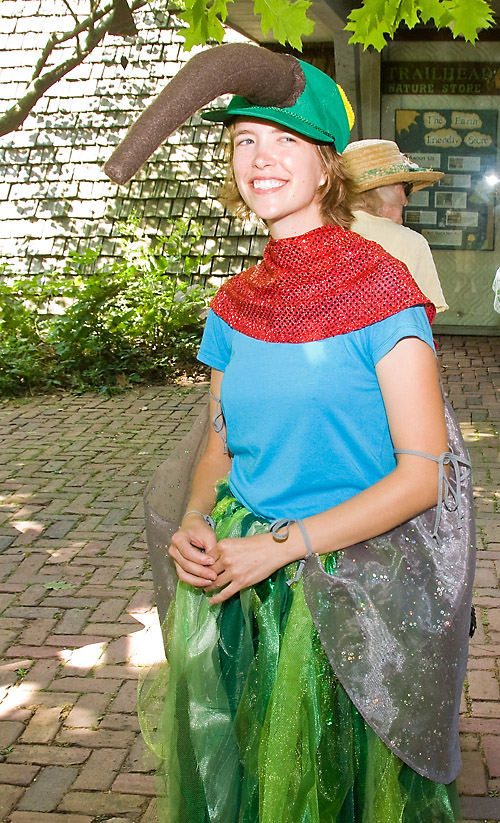
Cassandra Dressed Up as a Male Ruby-throated Hummingbird
To promote interest for the event, Cassandra dressed up as a hummingbird. Note the red gorget. The red signifies that the Ruby-throated hummingbird is a male.
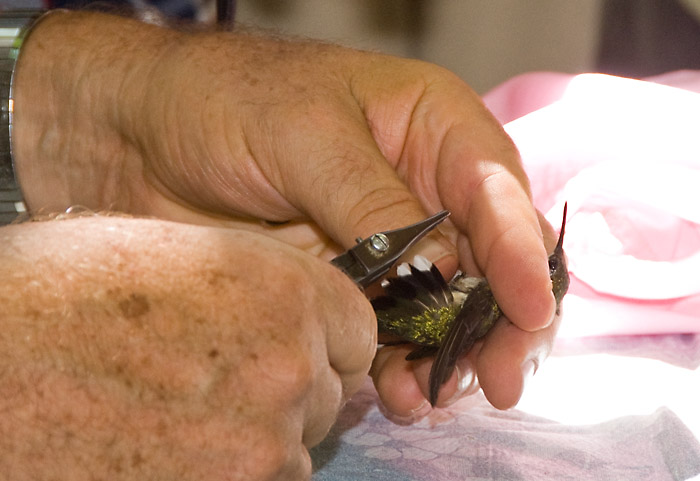
Vern Attaches Band to Hummingbird
After recording measurements of each hummingbird, Vern carefully places a serialized band around its tiny leg.
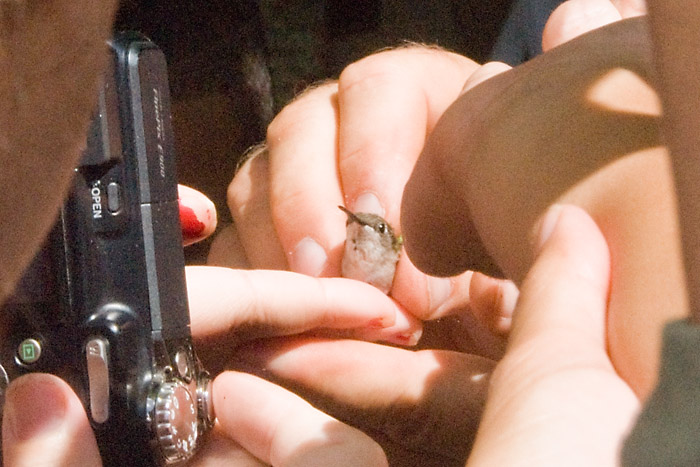
Feeling the 1200 Heartbeats per Minute of a Hummingbird
While at the festival, people lined up for a brief chance to feel the 1200 beat per minute heartbeat of a hummingbird.
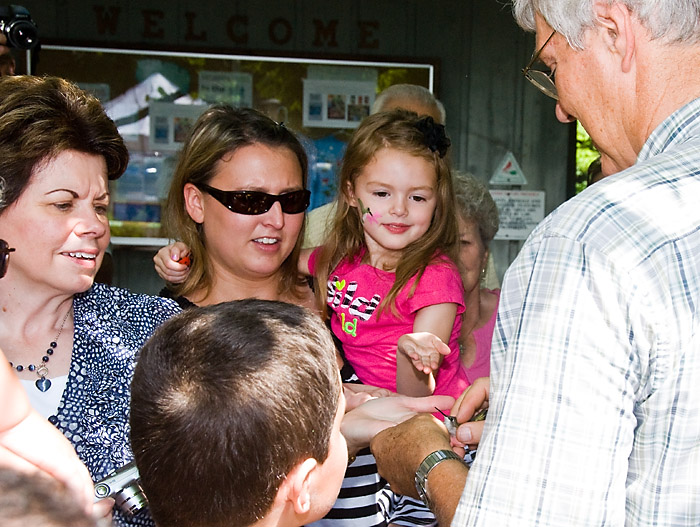
Feeling the Heartbeat of a Hummingbird
A hummingbird's heart beats at 1200 beats per minute. After banding, and before release, Vern would let people experience what the heartbeat feels like. This does not harm the hummingbird as they are still in a state of torpor. After a couple of minutes, Vern very carefully places the hummingbird into the adoptee's hand and moments later, the hummingbird springs to life. Note that Verne is the only one holding the hummingbird and that the utmost care is taken to safely release the banded hummingbird.
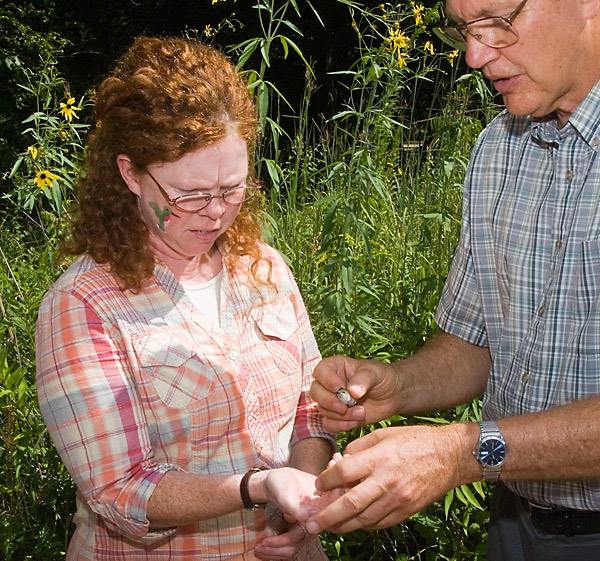
For Release Vern Places the Ruby-throated Hummingbird in Peggy's Hand
Vern carefully places the banded hummingbird in Peggy's hand for release.
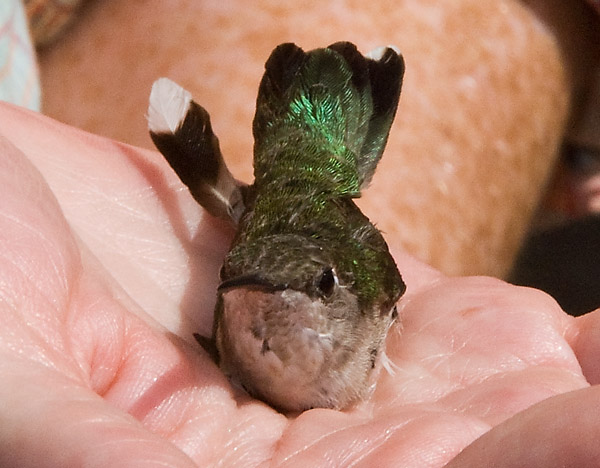
Closeup of Peggy's Adopted Ruby-throated Hummingbird
After a few seconds, the hummingbird "snapped" out of the torpor and flew away. Vern stated that after adoption, if he captures the banded bird again, he will send the adopters a letter stating where and when he re-captured the banded bird. With the 15 annual Hummingbird, in the last few years, Vern has been sending out 120-150 letters per year.
The Peoria Audubon Society wishes to thank the Peoria Park District for providing the facility and the logistics for the event. And, a wealth of appreciation goes to Vernon Kleen for coming to Peoria to share little bit of magic with these amazing little dynamos of beauty and energy.